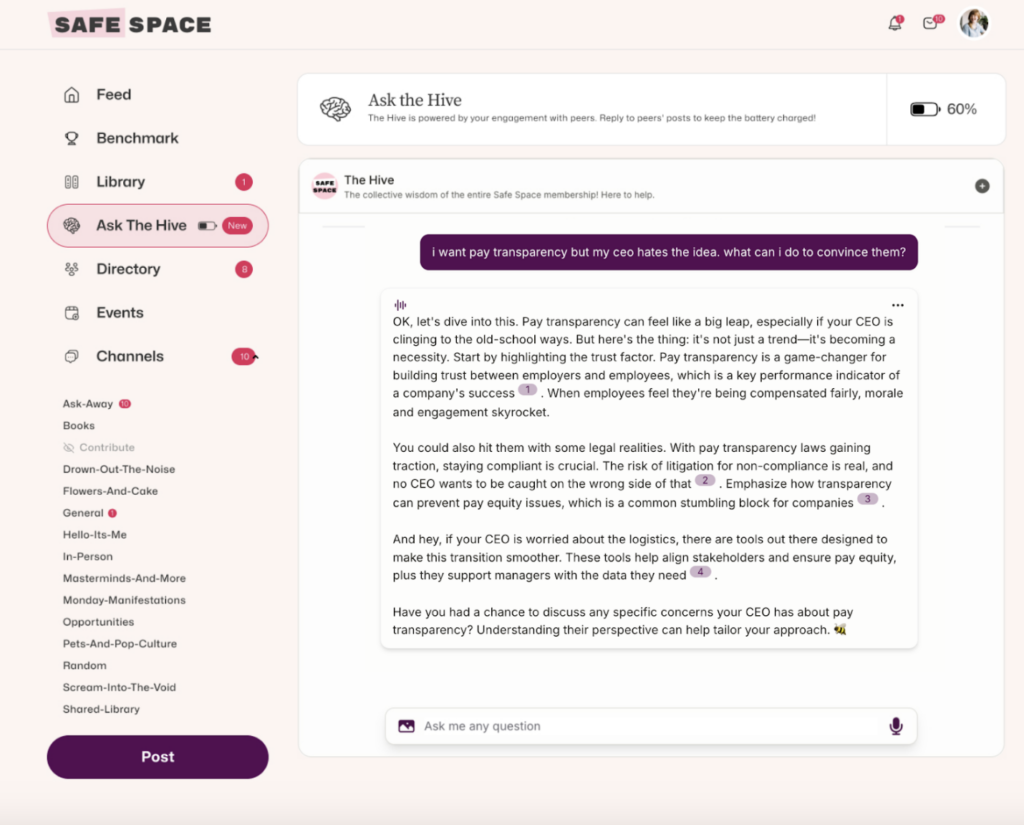
I have to admit when AI started to take off late last year I had a lot of doubts.
I was worried that AI would just amplify the bias that already exists (it does) and I couldn’t quite understand how my work would or could radically change.
But with every passing day I hear about another way to leverage AI and at this point, it’s becoming hard to avoid.
That’s what prompted this series about Generative AI! I wanted to be sure to share as much as I knew about how to leverage AI but also be mindful of the risks that come with using any new technology.
Last week, we kicked off the series with Amanda Halle who shared her thoughts around AI in HR with how to leverage AI, risk to be aware of and what time and financial commitment is required.
This week, I’m focused on specific use cases for HR where AI can help improve company culture.
Leveraging Generative AI can have a positive impact on company culture by:
- Increasing job satisfaction
- Improving efficiency and decision making
- Streamlining workflows and operational processes
How you may ask?
Let’s look at these 3 areas in HR:
- Recruiting
- Company policies & procedures
- Performance
For each area I’ll cover ways Generative AI is currently being used, what to be mindful of and thoughts from some of my friends who have experience!
To note: do not enter confidential information in ChatGPT.
Recruiting:

How AI is currently being used in recruiting:
- Candidate // job matching
- Identifying potential candidates
- Automating recruiting tasks
- Summarizing interview notes
The benefits:
- Can help reduce redundant tasks which improves job satisfaction
- Improves recruiter workload which helps with job burnout
- Reduces cost per hire because processes are more efficient
A free way to get started:
You can use ChatGPT for things like interview questions, email templates, and summarizing interview notes.
GPT for HR gives you dozens of prompts to use!
JOIN 150K+ HR LEADERS
Get insights, learnings, and advice on how to build companies and cultures that people actually love.
No spam. Unsubscribe any time.
What to be mindful of:
One of the things we’re seeing right now is many LLMs are built with biased inputs. Bias in, bias out. You want to check the dataset for bias to make sure what you’re scaling is inclusive. This is especially important for HR teams looking to increase the representation of their hiring funnel. Are your AI-generated job descriptions inclusive? Are the AI-summaries of your interviews inclusive? AI can be a useful tool, but it needs to be monitored for harmful patterns. – Kat Fergerson, Mathison
Additional Resources:
Company Policies & Procedures

The hardest part of writing a new policy or procedure? Getting started.
Enter AI.
How AI is currently being used:
- Drafting V1 of policies
- Generating frameworks (ex: onboarding)
- Drafting internal communications
- Drafting an AI policy for internal use (inception?)
The benefits:
- You don’t have to start from scratch
- Saves time and resources
- Streamlines processes
- Identifies gaps in existing processes
What to be mindful of:
- Confidential info shouldn’t be entered in ChatGPT
- You still need to fact check
- Editing is usually required to match the style, tone and culture of your organization.
Additional resources:
Having clear policies and procedures can have a positive impact on culture. Employees value transparency and consistency!
AI is like an executive assistant. Don’t expect AI to do your job, but to speed you up, in segmenting and prioritizing candidates, checking your language, summarizing call notes, highlighting insights, and creating initial drafts of emails. It’s the next level up from automation. – Jeet Mukerji, CEO Kinfolk
Performance:

Helping employees identify where they can grow and develop has a positive impact on company culture and, you guessed it, performance!
As you know, I have a love/hate relationship with performance management. I think most performance management processes are riddled with bias.
I included this section because I found the content helpful and thought you might as well!
How AI is currently being used in performance management:
- Analyzing performance data
- Summarizing performance
- Suggesting goals
- Provide coaching opportunities
The benefits:
- Real time feedback for employees
- Personalized performance suggestions
- Predicting employee performance
- Creating employee development plans
- Identifying potential bias in feedback
What to be mindful of:
- Bias (as always!)
- Overemphasizing metrics
- Lack of context
- It should never replace manager’s duties
Additional resources:
Next on the culture quest:

In honor of Labor Day, I’m exploring the topic of our relationship with work.
I have A LOT to say. Shocker to no one.
Food for thought: How would you describe your relationship with work?My answer: unbalanced, but I’m working on it!


